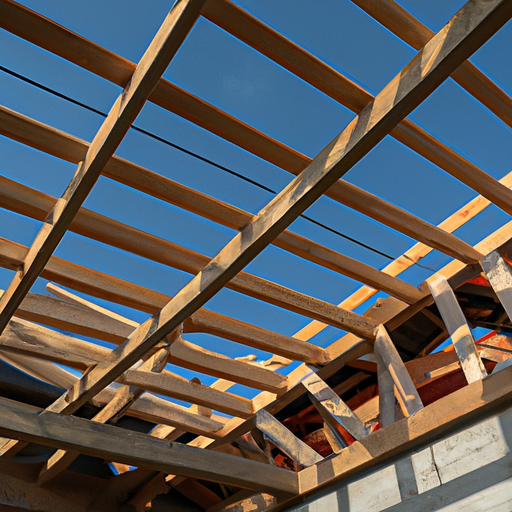Understanding Different Types of Roof Designs: A Comprehensive Guide
Understanding different types of roof designs is essential when it comes to roof construction. The design of a roof not only plays a crucial role in the overall aesthetics of a building but also determines its functionality and durability. In this comprehensive guide, we will explore various types of roof designs and their features.
1. Gable Roof: The gable roof design is one of the most common and recognizable designs. It consists of two sloping sides that meet at a ridge to form a triangular shape. This design allows for efficient water run-off and provides ample attic space. Gable roofs are versatile and can be adapted to various architectural styles.
2. Hip Roof: A hip roof is characterized by slopes on all four sides. Unlike the gable roof, all sides of the hip roof come together at the top to form a ridge. This design offers superior stability, making it suitable for areas with high wind or hurricane conditions. Hip roofs provide great water drainage and additional living space in the form of attics or dormers.
3. Mansard Roof: The mansard roof design is commonly associated with French architecture. It features two slopes on each of the four sides, with the lower slope being steeper than the upper slope. This design allows for maximum living space under the roof. Mansard roofs are often utilized in buildings with multiple stories as they provide extra headroom on the upper levels.
4. Flat Roof: As the name suggests, a flat roof has little to no slope. It is a simple and cost-effective design, commonly used in commercial and modern residential buildings. Flat roofs provide additional space for installations such as HVAC systems or solar panels. However, proper drainage systems are essential to prevent water accumulation and potential leaks.
5. Gambrel Roof: The gambrel roof design is reminiscent of a barn or Dutch colonial style. It features two different slopes on each side, with the lower slope being steeper than the upper slope. Gambrel roofs provide more space compared to a traditional gable roof, making them suitable for residential buildings or storage purposes.
6. Shed Roof: A shed roof is a single sloping roof that is commonly used for smaller structures such as sheds, porches, or extensions. This simple and cost-effective design allows for easy water drainage and is often used to complement modern architectural styles.
By understanding the different types of roof designs, you can make informed decisions during the roof construction process. Consider factors such as climate, architectural style, and desired functionality when choosing the most suitable roof design for your building. Remember to consult professionals and adhere to local building codes to ensure a safe and successful roof construction project.
Essential Components of Roof Construction: From Trusses to Rafters
When it comes to roof construction, there are several essential components that play a crucial role in ensuring the structural integrity and longevity of the roof. From trusses to rafters, each element serves a specific purpose in supporting the weight of the roof and transferring it to the walls of the building.
One of the key components of roof construction is the truss system. Trusses are pre-fabricated triangular frameworks made of wood or steel that provide support and stability to the roof. They are designed to distribute the weight evenly and efficiently, ensuring that the load-bearing capacity of the roof is maximized. Trusses are typically installed at regular intervals along the length of the roof and are connected to the walls using special connectors.
Another important component of roof construction is the rafters. Rafters are sloped beams that form the main framework of the roof. They are typically installed parallel to each other and are attached to the top plate of the walls. Rafters provide support for the roof covering and help shape the roof’s pitch or slope. In addition to supporting the weight of the roof, rafters also play a role in distributing the weight evenly to the load-bearing walls.
In addition to trusses and rafters, roof construction also includes other essential components such as sheathing, underlayment, and roofing materials. Sheathing is a layer of plywood or oriented strand board (OSB) that is attached to the rafters or trusses. It provides a solid base for the roof covering and helps distribute the weight evenly. Underlayment, on the other hand, is a waterproof barrier that is installed on top of the sheathing to protect the roof from water damage.
Finally, the choice of roofing materials is crucial in roof construction. Common roofing materials include shingles, tiles, metal panels, and membranes. Each type of material offers different levels of durability, aesthetics, and energy efficiency. The selection of roofing materials depends on factors such as the climate, budget, and architectural style of the building.
In conclusion, understanding the essential components of roof construction is vital for ensuring a well-built and functional roof. Trusses, rafters, sheathing, underlayment, and roofing materials all work together to create a sturdy and long-lasting roof. By carefully considering these components and their specific requirements, homeowners and roofing professionals can ensure the structural integrity and durability of the roof for years to come.
Choosing the Right Materials for Your Roof: A Detailed Overview
When it comes to roof construction, choosing the right materials is crucial for ensuring durability, energy efficiency, and overall aesthetics. With a wide range of roofing materials available in the market, it can be overwhelming to make a decision. However, understanding the characteristics and advantages of each material can help you make an informed choice.
One of the most popular roofing materials is asphalt shingles. These shingles are cost-effective, easy to install, and come in a variety of colors and styles. They are also relatively low-maintenance and can last up to 30 years. Another advantage of asphalt shingles is their resistance to fire and wind, making them a suitable choice for areas prone to extreme weather conditions.
If you’re looking for a more eco-friendly option, consider metal roofing. Metal roofs are highly durable, energy-efficient, and recyclable. They can withstand harsh weather conditions, including heavy snow and high winds. Additionally, metal roofs have a long lifespan, often lasting more than 50 years. They are available in various designs and coatings to enhance their visual appeal.
For those seeking a traditional and timeless look, cedar shake or shingle roofing is an excellent choice. Cedar roofs offer natural beauty and can enhance the overall aesthetics of your home. They have excellent insulation properties, providing energy efficiency and reducing heating and cooling costs. However, cedar roofs require regular maintenance and should be treated to prevent issues such as moss growth and decay.
If you live in an area with a hot climate, clay or concrete tiles might be the right option for you. These tiles have excellent heat resistance and can withstand extreme temperatures. Additionally, they are known for their longevity and durability, lasting up to 50 years or more. The various shapes and colors available in clay and concrete tiles allow for versatile and attractive roofing designs.
Another option to consider is synthetic roofing materials, such as composite shingles or rubber slate. These materials mimic the appearance of traditional roofing materials while offering enhanced durability and resistance to weathering. Synthetic roofing materials are lightweight, easy to install, and often come with longer warranties.
When choosing the right materials for your roof, it’s essential to consider factors such as climate, budget, durability, and maintenance requirements. Additionally, consult with a professional roofing contractor who can provide expert advice based on your specific needs.
Remember, investing in high-quality roofing materials can significantly impact the longevity and performance of your roof, providing you with peace of mind and a beautiful home for years to come.
Step-by-Step Guide to Proper Roof Installation and Maintenance
Proper roof installation and maintenance are essential for ensuring the long-term durability and functionality of any building. Whether you are constructing a new roof or repairing an existing one, following a step-by-step guide is crucial to ensure the job is done correctly and efficiently.
The first step in roof installation is to thoroughly inspect the existing structure, ensuring that it is strong enough to support the weight of the new roof. Any weak spots or damage should be identified and repaired before proceeding. It is also important to check for any local building codes or regulations that may dictate specific requirements for roof construction.
Once the structure has been assessed and deemed suitable, the next step is to install the underlayment. This protective layer acts as a barrier against moisture, preventing leaks and water damage. There are different types of underlayment available, such as asphalt felt or synthetic materials, and the choice depends on factors such as climate and budget.
The next crucial step is installing the roofing material itself. There are various options available, including asphalt shingles, metal panels, tiles, or even thatch. The choice depends on factors such as aesthetic preferences, durability, and budget. It is important to carefully follow the manufacturer’s instructions for proper installation techniques to ensure a watertight and secure roof.
Proper ventilation is another essential aspect of roof installation. Improper ventilation can lead to a buildup of moisture, which can cause damage to the roofing materials and even lead to mold growth. Adequate intake and exhaust vents should be installed to ensure proper air circulation.
Maintaining a roof is just as important as the initial installation. Regular inspections should be conducted to identify any signs of damage or wear and tear. It is recommended to schedule professional inspections at least once a year, especially after severe weather events. In addition, regular cleaning, gutter maintenance, and removal of debris can help prevent issues such as water pooling or clogged drains.
In conclusion, proper roof installation and maintenance are vital for the longevity and functionality of any building. Following a step-by-step guide and adhering to industry best practices is crucial to ensure a properly installed roof. Regular inspections and maintenance are essential to detect and address any issues promptly. By providing proper care and attention, your roof will continue to protect your building for many years to come.



